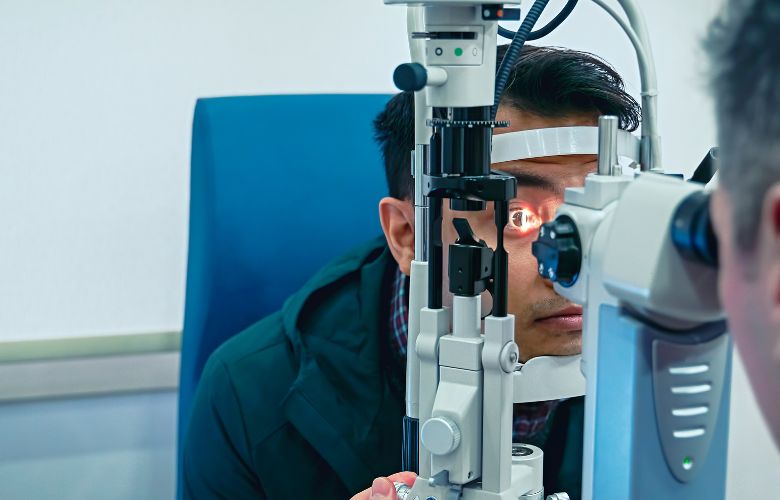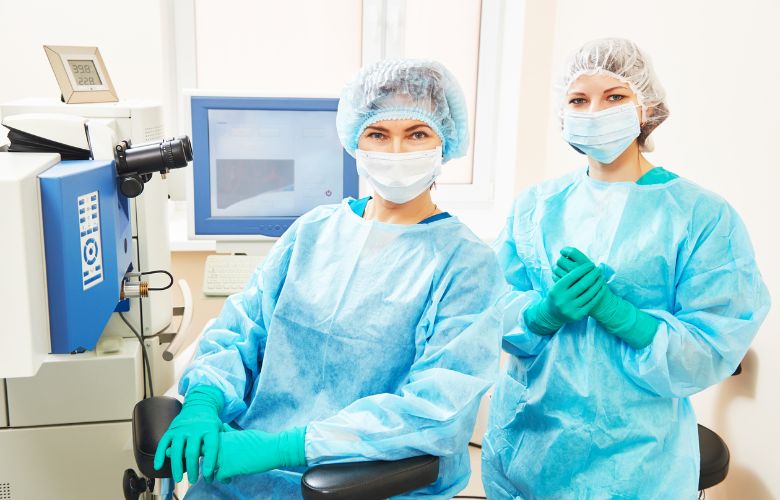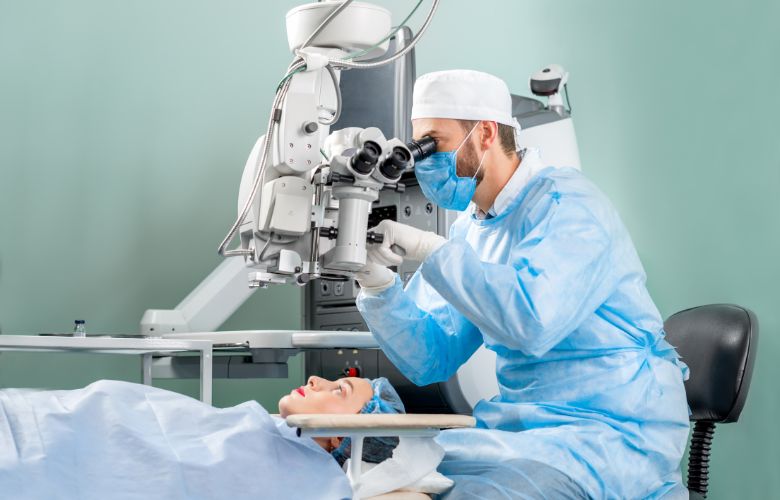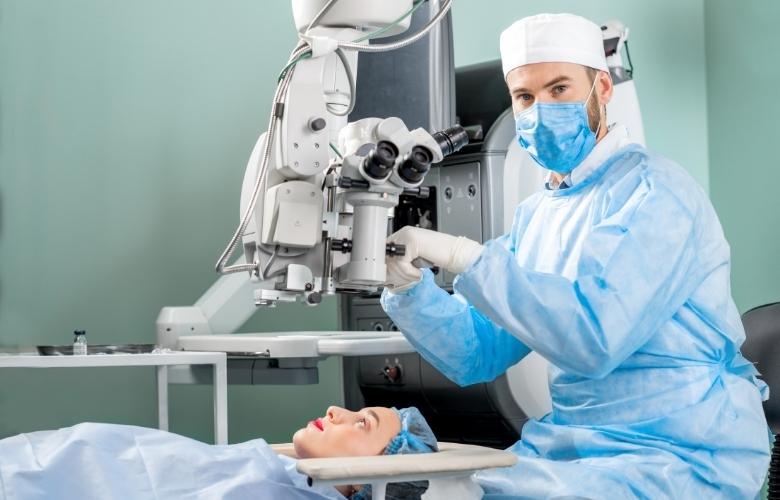In recent years, advancements in medical technology have revolutionized the field of eye care, offering new and innovative ways to correct vision and treat eye conditions. One such advancement is the use of laser technology in eye surgery, which has proven to be a safe, effective, and minimally invasive way to correct vision problems. With this technology, patients can say goodbye to the inconvenience of wearing glasses or contact lenses and enjoy clear, sharp vision without any physical aids. The use of lasers in eye surgery has opened up new possibilities for treating a range of eye conditions, including nearsightedness, farsightedness, astigmatism, and even cataracts. In this article, we’ll explore how laser technology is changing the game in modern eye surgery and how it’s making vision correction and eye treatment more accessible and effective than ever before.
» Know more about Eye Pain: What Are the Causes & Treatment? Click Now
What is LASIK eye surgery?

LASIK is the most common and best kind of eye surgery that someone can get today. The name LASIK stands for laser-assisted in situ keratomileusis, and it is the perfect surgery for those who already have a prescription or those who want immediate sight correction. During this eye surgery in Sydney, the laser that is used for cutting precisely changes the shape of the cornea, which is the dome-shaped tissue in front of your eye. By doing this, your vision will be improved, and changes will be noticed after surgery is completed.
Why is it done?

There are a few reasons why LASIK is the best option for laser-type surgeries. It is the best option for those who have nearsightedness, which is also known as myopia. The reason why people have myopia is that the eyeball is slightly longer than normal, and this causes the cornea to curve too sharply. Due to that, the light rays focus in front of the retina, and blurry vision is experienced.
Another issue is to take care of the opposite condition, which is farsightedness, also known as hyperopia. In this condition, the eyeball is shorter, which makes the light go behind the cornea. Both conditions can be solved with LASIK by modifying the cornea, and another condition that can be corrected is astigmatism, which is quite a common condition.
Are there any risks?

Like any surgery, there are some risks that you should know about, even if they are extremely rare. The most common complications are dry eyes and temporary vision problems like glare, but they clear up after a few weeks. Sometimes these issues can stay for a few months, but once they are gone, you will have perfect sight.
Some other risks that come with LASIK are overcorrections, under-corrections, flap problems, regression, or changes in vision. While these risks might seem scary, they are very rare, and as we mentioned, they will go away after some time, a risk worth taking. There are also some conditions that increase the chances of these risks happening, which is why you should consult with your surgeon beforehand.
How to prepare for LASIK

Preparing for LASIK eye surgery requires a few simple steps to ensure the best possible outcome and minimize the risk of complications. Here are some tips on how to prepare for LASIK:
- Schedule a Consultation: Preparing for LASIK requires going to the consultation. A thorough eye exam will be performed by the surgeon at this appointment to evaluate your general eye health, vision needs, corneal thickness, and other aspects that could influence your eligibility for LASIK. Additionally, the surgeon will go over the procedure’s risks, rewards, and expected results, as well as any potential alternatives that might be better suited to your particular requirements.
- Stop Wearing Contact Lenses: The accuracy of the measurements made during the consultation may be impacted by the shape of your cornea, which can change if you wear contact lenses. Consequently, depending on the kind of lenses you wear, you will need to stop wearing contact lenses for a certain amount of time prior to the procedure. Prior to surgery, soft contact lenses must normally be removed for two weeks, whereas hard or gas-permeable lenses may need to be removed for up to four weeks.
- Avoid Certain Medications: There is a chance of bleeding both during and after surgery while using certain medications. If you use any prescription drugs or dietary supplements, it’s crucial to let the surgeon know. You should also heed their advice regarding which drugs to avoid taking before surgery. For a certain amount of time prior to the procedure, you may need to stop taking certain medications, including aspirin, ibuprofen, and warfarin, which thin the blood.
- Arrange Transportation: You can return home the same day after having LASIK because it is an outpatient treatment. However, since your vision might be momentarily hazy or blurry after the procedure, you won’t be able to drive yourself home. Therefore, you will need to make transportation arrangements for the day of the procedure to and from the surgical center.
- Plan Time Off Work: Even though the majority of patients are able to resume their normal routines and go back to work a few days after surgery, it’s still important to schedule some time off of work to allow for proper healing and recovery. The length of time you’ll need off work will depend on your employment responsibilities and the kinds of activities you usually do.
- Follow Post-Operative Instructions: Detailed advice on how to take care of your eyes following surgery will be given to you by the surgeon. Wearing a shield over your eyes while you sleep and utilizing eye drops are a few examples of how to do this. To reduce the possibility of difficulties and assure the best outcome, it is crucial to carefully follow these directions. In order to track your progress and guarantee optimal healing, you will also need to show up for follow-up consultations with your surgeon.
What Should Your Expectations Be

When it comes to the LASIK eye surgery in Sydney, your expectations should be quite high, as it will improve your sight drastically. You should be prepared to have your sight carefully evaluated by a surgeon, as the best long-term results from LASIK come when everything is done carefully.
Here are some expectations to keep in mind:
- Improved vision: The very successful LASIK technique can treat refractive problems such as astigmatism, nearsightedness, and farsightedness. The clear front portion of the eye, known as the cornea, is reshaped with a laser during the treatment so that light entering the eye is properly focused on the retina. Your vision may be enhanced, and you might be less reliant on contacts or glasses as a result.
- Risks: As with any surgery, there are some risks associated with LASIK, despite the fact that it is generally a safe and successful procedure. The following are some potential risks: under- or overcorrection of vision, which may necessitate subsequent surgery; dry eyes, which can be treated with eye drops; halos or glare around lights, which may be temporary or permanent; and infection, which is uncommon but can be dangerous. It is crucial to go over these risks with your eye doctor so you can decide if LASIK is the appropriate procedure for you.
- Follow-up care: You must visit your eye doctor again soon after LASIK surgery for follow-up appointments so they may check on your eyesight and the healing process as well as do routine checkups. Within the first few days following surgery, your doctor will likely set up a follow-up appointment. Additional appointments will likely be set up over the course of the following few months. It is crucial that you show up for these sessions on time and that you let the doctor know if your vision changes or if you experience any pain or discomfort.
Post-Op Recovery And The Results

Once the procedure is completed, you will feel that your eyes are itching or slightly burning. You may also experience a bit of watering, but that is completely normal. Once those sensations go away, you will recover your vision, and it will be better than ever before. Very rarely, you will be required to take pain eye drops. It will all depend on how long your eye needs to heal.
When it comes to the recovery period, there is not much that you have to do on your part. Just follow the instructions that the doctor gives you, and go for the checkups if necessary. After a couple of days to a few weeks, your sight should be fully restore
Other Modern Eye Surgeries

In addition to LASIK, there are several other types of modern eye surgeries that are commonly performed today. Here are some of them:
- PRK (Photorefractive Keratectomy):
An excimer laser is used in PRK, a type of laser eye surgery, to reshape the cornea. Similar to LASIK, PRK involves removing the epithelium from the cornea before using a laser to reshape it. This differs from LASIK in that the flap is not created in the cornea. The epithelium then naturally regenerates during the following few days. People who may not be good candidates for LASIK because of thin or irregular corneas, or for other reasons, should consider PRK. Due to the need for epithelium regeneration and the fact that PRK recovery times are typically longer than LASIK recovery times, patients should expect some discomfort in the first few days following surgery.
- SMILE (Small Incision Lenticule Extraction):
With the use of a femtosecond laser, a smaller, more accurate incision is made in the cornea during the SMILE procedure, which reshapes the cornea by removing a small piece of tissue (lenticule). The absence of the need to create a corneal flap during SMILE surgery, in contrast to LASIK and PRK, may lower the risk of problems. For patients with thin corneas, SMILE is also a viable choice. SMILE patients frequently have a quicker recovery than those who undergo PRK or LASIK, and they could feel less pain afterwards.
- Cataract Surgery:
An artificial lens implant is used to replace the eye’s clouded natural lens during cataract surgery. Removing the cataract, which can lead to glare, fuzzy vision, and trouble seeing at night, this procedure can improve eyesight and lessen cataract symptoms. To remove the hazy lens during cataract surgery, a small incision is usually made in the eye. Ultrasound energy is commonly used to break up the cloudy lens. A synthetic lens implant can be used to replace the hazy lens after the cloudy lens has been removed, potentially restoring vision. One of the most popular surgical procedures performed globally, cataract surgery is widely regarded as a secure and successful procedure.
- Corneal Transplant Surgery:
A healthy donor cornea is used to replace a diseased or damaged one during corneal transplant surgery. This procedure could be required if the cornea has been harmed by an accident, an infection, or a condition like keratoconus. The surgeon replaces the injured cornea with a donor cornea that has been precisely matched to the patient’s eye during the procedure. Tiny stitches that hold the new cornea in place will be removed in a few months. Patients may experience better vision and fewer side effects after undergoing corneal transplant surgery, which has a high success rate.
- Glaucoma Surgery:
Glaucoma surgery is a procedure to lower the pressure inside the eye and prevent further damage to the optic nerve, which can lead to vision loss. There are several types of glaucoma surgery, including trabeculectomy, which involves creating a small flap in the eye to allow fluid to drain out of the eye and lower the pressure, and minimally invasive glaucoma surgery (MIGS), which uses tiny incisions and stents to improve fluid drainage. Glaucoma surgery is typically recommended when medications and other treatments are not effective in controlling the pressure inside the eye. The success rate of glaucoma surgery varies depending on the type of surgery and the severity of the glaucoma.
Final Words
Modern eye surgery has come a long way in recent years, offering a range of safe and effective options for patients with vision problems. LASIK is one of the most popular and well-known types of laser eye surgery, but there are other options available, such as PRK, SMILE, cataract surgery, corneal transplant surgery, and glaucoma surgery. Each type of surgery has its own benefits and risks, and it is important to consult with an eye doctor to determine which option is best for your individual needs. With advances in technology and surgical techniques, modern eye surgery continues to provide hope and improved vision for many people.


